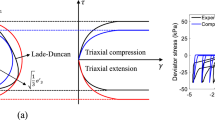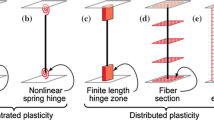Abstract
In simulations of geotechnical engineering, interface elements are versatile tools and are widely used in the modeling of the relative displacements between soils and structures. To consider the case of a local failure adjacent to a soil-structure interaction region, a partial mesh refinement should be performed. In this study, a three-dimensional (3D) interface element with an arbitrary number of nodes is developed as a new technique to reduce the complexity and difficulty of managing the various scales between soil and structure. An asymmetric number of nodes is permissible on the two sliding surfaces. In this manner, soil and structure can be discretized independently, and the various-scale model is established conveniently and rapidly. The accuracy of the proposed method is demonstrated through numerical examples. The various-scale approach is employed in an elasto-plastic seismic damage analysis of a buried concrete drainage culvert of a nuclear power plant. The results indicate that by applying the proposed method, the number of elements decreased by 72.5%, and the computational efficiency improved by 59% with little influence on accuracy. The proposed method is powerful for local damage evolution analyses of both soil and structure and possesses great practical significance and the potential for further application, especially for nonlinear analysis of large-scale geotechnical engineering.
Similar content being viewed by others
References
Liu H, Song E, Ling H I. Constitutive modeling of soil-structure interface through the concept of critical state soil mechanics. Mech Res Commun, 2006, 33: 515–531
Liu H, Ling H I. Constitutive description of interface behavior including cyclic loading and particle breakage within the framework of critical state soil mechanics. Int J Numer Anal Meth Geomech, 2008, 32: 1495–1514
Liu H, Martinez J. Creep behaviour of sand-geomembrane interfaces. GeoSynths Int, 2014, 21: 83–88
Zhang G, Zhang J. State of the art: Mechanical behavior of soilstructure interface. Prog Nat Sci, 2009, 19: 1187–1196
Zeghal M, Edil T B. Soil structure interaction analysis: Modeling the interface. Can Geotech J, 2002, 39: 620–628
Xiao Y, Stuedlein A M, Chen Q, et al. Stress-strain-strength response and ductility of gravels improved by polyurethane foam adhesive. J Geotech Geoenviron Eng, 2018, 144: 0417108
Day R A, Potts D M. Zero thickness interface elements-numerical stability and application. Int J Numer Anal Methods Geomech, 1994, 18: 689–708
Kong X J, Liu J M, Zou D G. Numerical simulation of the separation between concrete face slabs and cushion layer of Zipingpu dam during the Wenchuan earthquake. Sci China Technol Sci, 2016, 59: 531–539
Zou D, Xu B, Kong X, et al. Numerical simulation of the seismic response of the Zipingpu concrete face rockfill dam during the Wenchuan earthquake based on a generalized plasticity model. Comput Geotech, 2013, 49: 111–122
Liu J M, Kong X J, Zou D. G. Effects of interface models on deformation of interface between slab and cushion layer and slab stress of concrete faced rock fill dam (in Chinese). Chin J Geotechn Eng, 2015, 37: 700–710
Coutinho A L G A, Martins M A D, Sydenstricker R M, et al. Simple zero thickness kinematically consistent interface elements. Comput Geotech, 2003, 30: 347–374
Yu Y, Bathurst R J. Influence of selection of soil and interface properties on numerical results of two soil-geosynthetic interaction problems. Int J Geomech, 2016, 17: 04016136
Karabatakis D A, Hatzigogos T N. Analysis of creep behaviour using interface elements. Comput Geotech, 2002, 29: 257–277
Griffiths D V. Numerical modeling of interfaces using conventional finite elements. In: Proceedings of the 5th International Conference on Numerical Methods in Geomechanics. Nagoya, 1985
Pande G N, Sharma K G. On joint/interface elements and associated problems of numerical ill-conditioning. Int J Numer Anal Methods Geomech, 1979, 3: 293–300
Zienkiewicz O C, Best B, Dullage C, et al. Analysis of nonlinear problems in rock mechanics with particular reference to jointed rock systems. In: Proceedings of the 2nd International Conference Society of Rock Mechanics. Belgrade, 1970
Carol I, Alonso E E. A new joint element, for the analysis of fractured rock. In: Proceedings of the 5th ISRM Congress. International Society for Rock Mechanics, 1983
Wilson E L, Yuan M W, Dickens J M. Dynamic analysis by direct superposition of Ritz vectors. Earthquake Engng Struct Dyn, 1982, 10: 813–821
Frank R, Guenot A, Humbert P. Numerical analysis of contacts in geomechanics. In: Proceedings of the 4th International Conference On Numerical Methods in Geomechanics. Rotterdam, 1982. 37–42
Herrmann L R. Finite element analysis of contact problems. J Soil Mechs Foundations Div, 1978, 104: 1043–1057
Ghaboussi J, Wilson E L, Isenberg J. Finite element for rock joints and interfaces. J Soil Mechs Foundat Div, 1973, 99: 833–848
Wilson E L. Finite elements for foundations, joints and fluids. In: Finite Elements in Geomechanics. Chichester: Wiley, 1977. 319–350
Goodman R E, Taylor R L, Brekke T L. A model for the mechanics of jointed rocks. J Soil Mechs Foundations Div, 1968, 94: 637–660
Clough G W, and Duncan, J. M. Finite element analyses of retaining wall behavior. J Soil Mech Found Div, 1971, 97: 1657–1673
Hu L, Pu J L. Application of damage model for soil-structure interface. Comput Geotech, 2003, 30: 165–183
Liu J, Zou D, Kong X. A three-dimensional state-dependent model of soil-structure interface for monotonic and cyclic loadings. Comput Geotechnics, 2014, 61: 166–177
Xue X, Yang X, Liu E. Application of the modified goodman model in soil nailing. Int J Geomech, 2011, 13: 41–48
Fairbairn E M R, Paz C N M, Ebecken N F F, et al. Use of neural networks for fitting of FE probabilistic scaling model parameters. Int J Fract, 1999, 95: 315–324
Wisnom M R. Modelling discrete failures in composites with interface elements. Composites Part A-Appl Sci Manufacturing, 2010, 41: 795–805
Karabatakis D A. Study of the Creeping Response of the Interface Elements. Dissertation for the Doctoral Degree. Thessaloninki: Aristotle University of Thessaloniki, 2000
Samadhiya N K, Viladkar M N, Al-Obaydi M A. Three-dimensional joint/interface element for rough undulating major discontinuities in rock masses. Int J Geomech, 2008, 8: 327–335
Wang X C. Finite Element Method (in Chinese). Beijing: Tsinghua University Press, 2003
Chen K, Zou D, Kong X, et al. A novel nonlinear solution for the polygon scaled boundary finite element method and its application to geotechnical structures. Comput Geotechnics, 2017, 82: 201–210
Chen K, Zou D, Kong X. A nonlinear approach for the three-dimensional polyhedron scaled boundary finite element method and its verification using Koyna gravity dam. Soil Dyn Earthquake Eng, 2017, 96: 1–12
Chen K, Zou D, Kong X, et al. An efficient nonlinear octree SBFEM and its application to complicated geotechnical structures. Comput Geotechnics, 2018, 96: 226–245
Zou D, Chen K, Kong X, et al. An enhanced octree polyhedral scaled boundary finite element method and its applications in structure analysis. Eng Anal Bound Elem, 2017, 84: 87–107
Qu Y, Zou D, Kong X, et al. A novel interface element with asymmetric nodes and its application on concrete-faced rockfill dam. Comput Geotechnics, 2017, 85: 103–116
Zhu Y W, Li W, Cai Y Q. An efficient inverse isoparametric mapping in FEM based on analytical character (in Chinese). J Wuhan Univ Hydraulic Electric Eng, 2002, 2: 62–65
Lian H, Kerfriden P, Bordas S P A. Shape optimization directly from CAD: An isogeometric boundary element approach using T-splines. Comput Methods Appl Mech Eng, 2017, 317: 1–41
Xu B, Zou D, Kong X, et al. Dynamic damage evaluation on the slabs of the concrete faced rockfill dam with the plastic-damage model. Comput Geotechnics, 2015, 65: 258–265
Yu X, Kong X, Zou D, et al. Linear elastic and plastic-damage analyses of a concrete cut-off wall constructed in deep overburden. Comput Geotechnics, 2015, 69: 462–473
Zhang G, Zhang J M. unified modeling of monotonic and cyclic behavior of interface between structure and gravelly soil. Soils Foundat, 2008, 48: 231–245
Lou M L, Pan D G, Fan L C. Effect of vertical artificial boundary on seismic response of soil layer (in Chinese). J Tongji Univ, 2003, 31: 757–761
Guo S S, Chen H Q, Li D Y, et al. Study of element-size effect on dynamic plastic-damage analysis of concrete (in Chinese). J Hydroelectr Eng, 2011, 30: 52–56
Pastor M, Zienkiewicz O C. A generalized plasticity, hierarchical model for sand under monotonic and cyclic loading. In: Proceedings of the 2nd International Symposium on Numerical Models in Geomechanics. Ghent, 1986
Pastor M, Zienkiewicz O C, Leung K H. Simple model for transient soil loading in earthquake analysis. II. Non-associative models for sands. Int J Numer Anal Methods Geomech, 1985, 9: 477–498
Xu B, Zou D, Liu H. Three-dimensional simulation of the construction process of the Zipingpu concrete face rockfill dam based on a generalized plasticity model. Comput Geotechnics, 2012, 43: 143–154
Lee J, Fenves G L. Plastic-damage model for cyclic loading of concrete structures. J Eng Mech, 1998, 124: 892–900
Hudson M B, Idriss I M, Beikae M. QUAD4M, A computer program for evaluating the seismic response of soil structure by variable damping finite element procedures. Report of Department of Civil & Environmental Engineering, University of California, Davis, 1993
Yoshida N, Kobayashi S, Suetomi I, et al. Equivalent linear method considering frequency dependent characteristics of stiffness and damping. Soil Dyn Earthquake Eng, 2002, 22: 205–222
Bayraktar A, Kartal M E. Linear and nonlinear response of concrete slab on CFR dam during earthquake. Soil Dyn Earthquake Eng, 2010, 30: 990–1003
Zuo X, Yang S C, Chen G X. Analysis on evolution of nonlinear seismic damage of subway station structure (in Chinese). Earthquake Resist Eng Retrof, 2010, 32: 110–116
Liu H, Song E. Seismic response of large underground structures in liquefiable soils subjected to horizontal and vertical earthquake excitations. Comput Geotechnics, 2005, 32: 223–244
Sweet J. Los angeles metro red line project: seismic analysis of the little Tokyo subway station. Report No CAI-097-100. Engineering Management Consultants, 1997
An X, Shawky A A, Maekawa K. The collapse mechanism of a subway station during the Great Hanshin earthquake. Cement Concrete Composites, 1997, 19: 241–257
Matsui J, Ohtomo K, Kanaya K. Development and validation of nonlinear dynamic analysis in seismic performance verification of underground rc structures. ACT, 2004, 2: 25–35
Author information
Authors and Affiliations
Corresponding author
Rights and permissions
About this article
Cite this article
Qu, Y., Zou, D., Kong, X. et al. A flexible various-scale approach for soil-structure interaction and its application in seismic damage analysis of the underground structure of nuclear power plants. Sci. China Technol. Sci. 61, 1092–1106 (2018). https://doi.org/10.1007/s11431-017-9269-7
Received:
Accepted:
Published:
Issue Date:
DOI: https://doi.org/10.1007/s11431-017-9269-7




